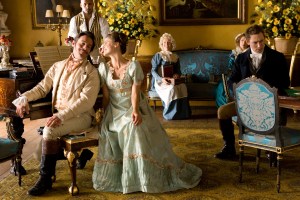Jennifer Coolidge, Keri Russell and Georgia King in Austenland.
Based on a novel by Shannon Hale, the movie Austenland (opening on Aug. 16) tells the story of Jane (Keri Russell), a single thirty-something who has an obsession with all things Jane Austen and longs for her own Mr. Darcy. Jane travels to England to stay at an Austen-themed resort and finds herself embroiled in her own love triangle of sorts. The film’s costume designer Annie Hardinge, a veteran of numerous British films and TV series including Shaun of the Dead and Little Britain, spoke to TIME about putting a modern spin on the styles of the Regency era.
Did you try to adhere strictly to this 18th century British style, or was it just a point of departure?
It was a point of departure as Jerusha Hess, the director, wanted to create a quirky look for Austenland and give the film a “heightened reality.” As the novel’s storyline is a modern take on the Regency style, we decided to use lots of color and to mix modern fabrics with period costume shapes, but to accentuate the look to create a parallel universe.

James Callis, Keri Russell and JJ Feild in Austenland.
How did you conceptualize the look of Jennifer Coolidge’s character Lizzie, particularly in contrast to Keri Russell’s Jane?
I kept Jane’s wardrobe as authentic and drab as possible with neutral colors and kept the patterns, trim and detailing on her clothes very subdued. As a contrast, Lizzie’s clothes reflected her big personality and her love of the color pink! All of her costumes were designed and made especially for Jennifer Coolidge with lots of embroidery, beadwork and opulent fabrics. The shapes of Lizzie’s dresses were authentic but slightly exaggerated, and I heightened her look by making each dress an homage to the color pink and by making each outfit as detailed as possible, especially emphasizing her extravagant hats and accessories.
How did you highlight class differences through dress?
Jane’s clothes and those of the servants were very simple shapes and soft colors with minimal detailing, and the fabrics were cottons and muslins. The other characters’ clothes were more over-the-top and had lots of embroidery, color and accessories; their clothes were made of silks, velvets and brocades.
What was behind the choice of costume for Jane’s “coming out” scene, when she decides to take charge of her story and shed her drab dresses?
I wanted Jane to look as authentic and beautiful as possible so that all the men would fall in love with her—a lovely Jane Austen heroine. Her dress was beautifully cut in cream silk, embroidered with gold and silver beadwork with matching accessories. It was ornate and elegant, as different as possible from her previous outfits.
How important was functionality in the Austenland costumes?
It was important that the costumes were functional so the actors could move properly. All the women in Austenland wore corsets of the period so that they walked in the proper way for the era. Darcy and the rest of the cast had to be able to ride on horseback and had to be dressed appropriately for that sequence.

